Take a seat

In 2023, design consultant Emma Elizabeth worked with Powerhouse to commission a series of bespoke furniture for the collaboration space in the new Building J at Castle Hill. The project showcases the works of eight innovative Australian designers: Adam Goodrum, Alexander Lotersztain, Daniel Emma, Dowel Jones, Ka-ra, Oku Space, Patryk Koca and Softer Studio.
Elizabeth tasked each designer to reinterpret one of their past creations for the new space and its surroundings – using spotted gum as a primary material. Andrew Yee spoke with Elizabeth and the designers about their approaches to the project.
Softer Studio
Design is a tangible experience, informed by years of knowledge, intuition and hours spent in the workshop, explains Dustin Fritsche, founder of Softer Studio.
Fritsche discovered his passion for creating at a young age while shaping surfboards, which then motivated him to pursue a cabinet-making qualification. These experiences influenced his hands-on approach through every step of the process, from conceptualising designs to spending countless hours in workshops covered in sawdust. Since founding Softer Studio in 2017, Fritsche has kept the brand a solo endeavour. His singular vision has paid off in achieving national renown for bespoke furniture with a playful approach to simplicity, accentuated by postmodernist design aesthetics.
In 2023, Emma Elizabeth partnered with Powerhouse to commission Softer Studio for a reinterpretation of the Thicker Chair using spotted gum.
Andrew Yee spoke with Softer Studio founder Dustin Fritsche about keeping things simple when designing furniture and the inspiration he draws upon when on the edge of sleep.


Andrew Yee What were your first thoughts when presented with the opportunity to redesign the Thicker Chair for Powerhouse?
Softer Studio I was genuinely surprised to be asked, as I mostly do residential work and I don’t often get to offer my work in areas where the broader public will see and possibly use my furniture. It’s a great honour to be among the other Australian designers, some of whom have been perfecting their craft for far longer than me.
AY What does it mean to have a 'soft' approach to design?
SS I try to keep things simple, be it the form or the construction method. Keeping things uncomplicated but with some kind of interesting or playful nuance within the design. I like to avoid trends and just make what I feel works for me. When a customer also likes what I am doing, I feel a great sense of satisfaction.
AY You've previously discussed how some of your best ideas come on the cusp of sleep, somewhere between dreams and reality. How does this sense of play and imagination change when it comes to collaboration or work for clients?
SS Drawing ideas from the subconscious is a very boundaryless approach, sometimes that’s where the best problem solving can occur. If I am working on a project, and I am stuck on a resolution for an idea or building method, I can regularly find the answer when my mind slows down in the moments before sleeping. Maybe an idea or combination of colour and shape will appear as I drift off to sleep. I don’t usually remember all the details but sometimes a certain aspect will present itself and is worth acting upon. This method can sometimes be a challenge when working with clients or colleagues but luckily, I can usually draw from past experiences and attained knowledge if there is a time critical decision to be made.
AY A vital project element was incorporating spotted gum – what was this timber like to work with, and did it present any challenges?
SS It was a nice change for me to use a different species of hardwood than what I usually use. I found the change of colours and tones – even within just one piece of timber – to be very interesting and they really popped when applying the clear coat. The oiliness of the timber can sometimes be a challenge when glueing up components, but I think the stock I was able to buy performed relatively well. It was also quite the workout moving it from each machine around the workshop, as it is quite a dense and heavy timber.
AY What does it mean to you as an Australian designer to have work commissioned by Powerhouse?
SS I was genuinely surprised to be included. I was lucky enough to deliver the chairs in person to the museum and the new renovation, art and design within is truly a great example of what the Australian creative community is capable of.
AY Do you have any upcoming projects, plans and works you'd like to share?
SS I have a few residential interior projects that will keep me pretty busy for a while, as well as some collaborative projects with Nick Rennie, my workshop and business partner for Oku Space. We are always scheming up new ideas and concepts. If time permits, we would like to add to our range of products and services.

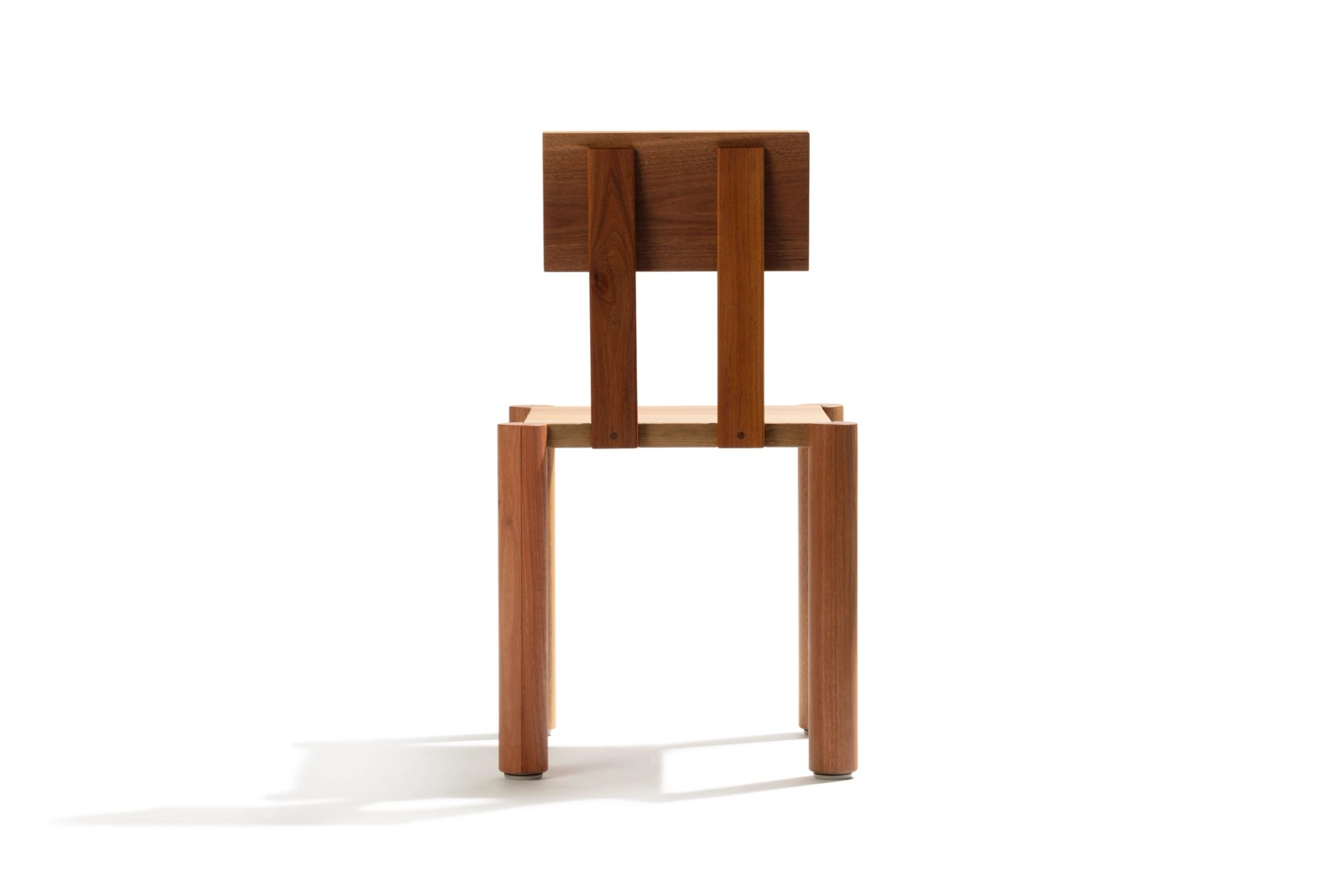
Patryk Koca
Sydney-based product designer Patryk Koca believes the balance between pragmatic functionality and poetic beauty is at the core of design.
From a young age to his tertiary education, Koca has always been driven to communicate with the world through design. Between 2014 and 2018, he headed product development and production at commercial furniture brand NAU, where he was exposed to the mechanisms of mass production. Koca recognised the challenge of creating unique products in a world where demand exceeds supply and wanted to converge his experiences into practical solutions. His process preserves the thoughtfulness of bespoke practices while incorporating digital technologies in production. Koca's furniture exemplifies minimalism with a flawless aesthetic that comes from being free from the limitations of smaller-scale manufacturing. Aside from creating his own pieces, Koca has collaborated with Sketch Interior, Hegi Design House, Studio Pip and architectural surface brand Evove.
In 2023, Emma Elizabeth partnered with the Powerhouse to commission Koca for a reinterpretation of his Kardo Chair in spotted gum.
Andrew Yee spoke with Koca about his pragmatism and approach to incorporating digital technologies into the design process.


Andrew Yee What were your initial thoughts when presented with the opportunity to reinterpret your Kardo Chair for Powerhouse?
Patryk Koca I was thrilled to be commissioned to create a piece for an institution that has greatly influenced my journey as a designer. Since my early childhood, I have vivid memories of visiting Powerhouse Museum on school excursions and on weekends with my parents. Its diverse collection and dynamic exhibition program have consistently served as enduring sources of learning and inspiration, spanning from my formative years into university and throughout my career.
AY A vital project element was incorporating spotted gum tree – what was your experience of working with the timber and did it present any challenges?
PK The Kardo Chair was originally designed for the 2022 Powerhouse New Australian Design exhibition curated by Emma Elizabeth. Inspired by the ephemeral Eucalyptusdom exhibition, the chair celebrates the variety of Australian species. Spotted gum was the perfect material to enhance the stylised finger joints with its natural tonal variations and contrast between grains.
The challenge of making the chairs in spotted gum was in achieving a refined result with a hardwood, which is generally less suited to fine details. Working with Jack Stannard from Iluka Studio to make the chairs was pivotal to achieving this. His practice focuses on using reclaimed timber and working with a broad range of species which he handpicks for every project.
The material connection to Dharug Land is extremely powerful, and like the architecture of the new Building J, which intentionally blends into the surrounding environment, it emphasises the importance of designing within the context of place.
AY Your practice marries practical design elements with digital technologies. Why was it imperative to make this part of your process?
PK In a world of fast paced specialisation, it is very hard to do everything yourself. I love making and designing bespoke pieces, but I also believe we can have a profound impact designing pieces that are sustainable by leveraging digital technologies and manufacturing in a responsible manner. Placing myself at the cross section of digital and the physical allows me to efficiently find a balance between ergonomics and challenging manufacturing constraints, while keeping an eye on creating a timeless and enduring aesthetic.
AY As a designer, how has your relationship with the concepts of practically and pragmatism evolved in your career?
PK I think through experiments and failure you gain invaluable experience. And experience inadvertently leads to accepting certain material properties and realities that you no longer feel the need to challenge as you progress through your career. You become more pragmatic, targeted and efficient. Ultimately collaborating with experienced and likeminded people is the key to all projects, in design and other aspects of life.
AY What does it mean to you as an Australian designer to have work commissioned by Powerhouse ?
PK It’s a great honour and privilege, marking what I hope will be just the beginning of a long and productive relationship with the museum. I hope that for me, these pieces will play a small role in inspiring the next generation of innovators and designers. It is an incredibly exciting time for Powerhouse with its Ultimo renewal and ambitious new centrepiece building in the heart of Parramatta, just a short River Cat ride from where I finished high school in West Ryde.
AY Do you have any upcoming projects, plans, and works you'd like to share?
PK Working on furniture commissions in public spaces is a gratifying and fulfilling aspect of my practice, and one I would like to continue to grow. I am presently in the process of delivering a series of custom benches for a Sydney landmark, the Queen Victoria Building, as part of its comprehensive refurbishment. These benches are envisioned to serve generations of visitors to come. Much like the Kardo Chairs, this project is a testament to collaboration, with exceptional makers from Gerringong, using native blackwood and blackened steel to create a fitting piece to its contextual surroundings.


Oku Space
Oku is a spatial theory term popularised in Japan, relating to the concept of space within and often hidden. At Melbourne-based designer furniture studio Oku Space, it is at the heart of the founders’ design approach.
The studio was born in 2021 out of Melbourne's pandemic lockdowns, when designer Nick Rennie and cabinet maker Dustin Fritsche were reassessing their relationships with their homes and their roles as designers. The nine-month lockdown experience inspired the pair to create products that enrich residential and commercial spaces with design choices which are elegant and functional.
In 2023, Emma Elizabeth worked with Powerhouse to commission Oku Space for a reinterpretation of the stackable OS1 Chair in spotted gum timber.
Andrew Yee spoke with Fritsche and Rennie about the concept of Oku and the challenges of working with spotted gum.

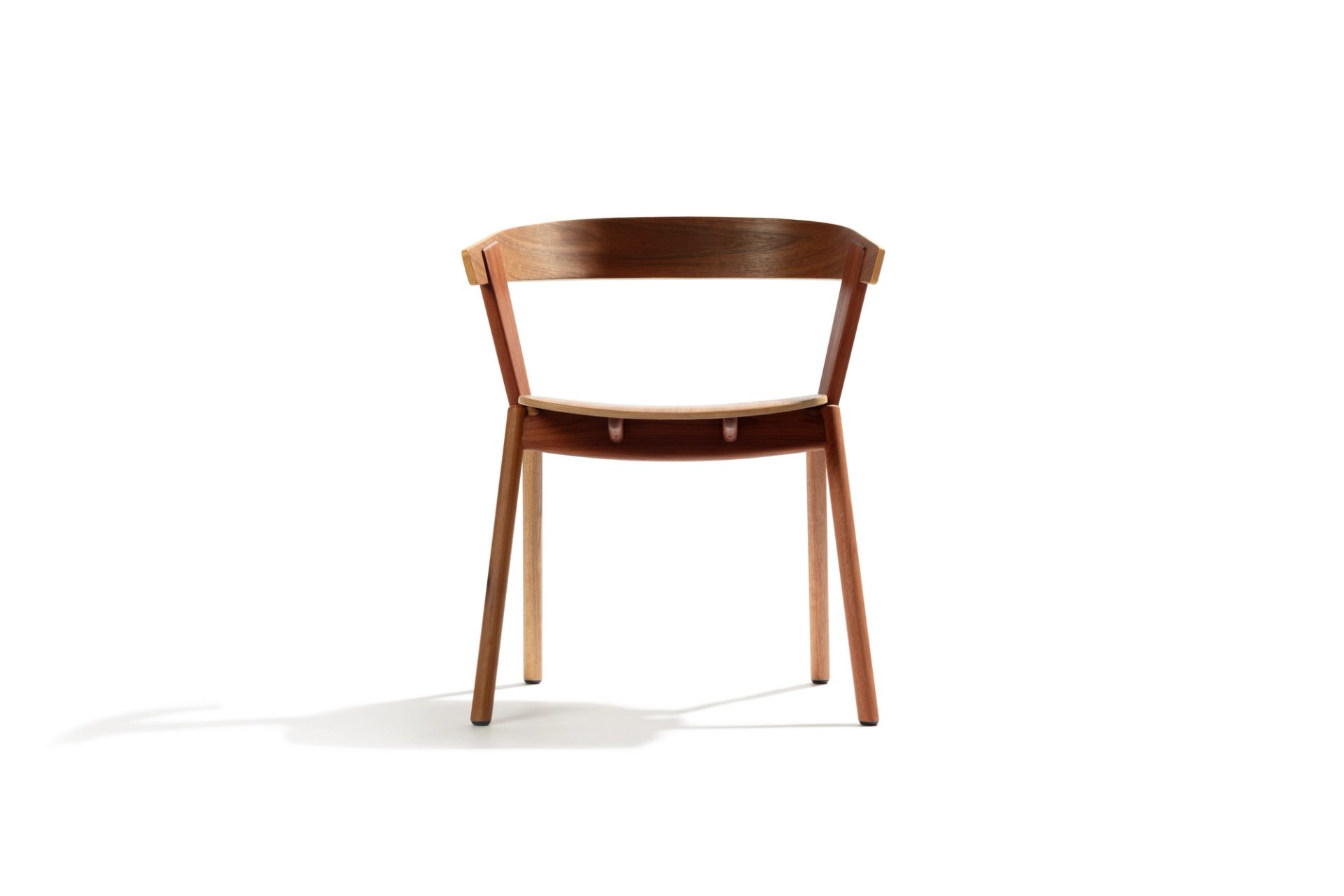
Andrew Yee What were your initial thoughts when presented with the opportunity to reinterpret your OS1 Chair for Powerhouse?
Oku Space We thought it was a wonderful initiative and we’re honoured to be selected along with the other designers.
AY What inspires you about the concept of Oku?
OS We love the idea that whatever the final result, the journey to get there is the most important. Each design is a result of rigorous conversation and testing of models and prototypes. This can translate directly to “the parts that are hidden”. Or it could be much more obvious and that may entail an unknown movement or surprise in the design.
While simplicity and elegance are at the core of our DNA, the idea of an object having a life of its own is part of the fun of what we do. The interaction of the object within a space, and when in use by a person, can show the success of a design, or not. We hope our designs will be used and most importantly enjoyed by those that interact with them.
AY What are some of the interesting challenges of designing a chair and how do you approach them with each new project?
OS Every project starts with a fresh slate. We always try to limit bringing any former bias to a new project, so we can hopefully look at each opportunity with fresh eyes. In saying that, the essence of a chair is to be sat in, so it has to conform to a number of parameters. This we find to be the interesting yet also difficult aspect to designing a chair. To try to create something unique within these parameters, where comfort and usability are paramount. We hope when people look at our designs as a whole, that although they might represent a similar language, the result for each is unlike any previous work, unless of course as part of a family of products.
AY A vital project element was incorporating spotted gum, which is endemic to the Caste Hill area. What was using this material like and did it present any challenges?
OS Spotted gum is always a difficult material to use, mainly because of its high oil content which makes it resistant to glue. However, it is also incredibly strong and machines very well.
AY What does it mean to you as Australian designers to have work commissioned by Powerhouse?
OS It is a wonderful opportunity to be involved with other Australian creatives. Everyone knows about Powerhouse and its importance in the Australian design landscape, so to be asked to submit our project has been a great honour.
AY Do you have any upcoming projects, plans and works you'd like to share?
OS We are constantly working and developing new ideas and projects. Some take weeks and others many years to reach fruition. Later this year there will be a launch of several new projects from Oku Space, but until then, we will both continue working on projects together as well as for our own design studios.


Ka Ra Studio
Ka Ra Studio is a Melbourne-based design studio renowned for creating practical products such as Penny, Buddy and Cinema Vase that are visually appealing and offer flexibility of use. Founder Katrina Ramm established the studio in 2019 with ‘home’ at the core of her design philosophy and a focus on making products that are affordable and compact to cater to the limitations of small footprint living. Ka Ra Studio has received widespread industry recognition including the VIVID Emerging Designer Awards, Design Fringe and a collaboration with sustainable timber social enterprise CERES Fair Wood for Melbourne Design Week 2023.
In 2023, Emma Elizabeth worked with Powerhouse to commission Ka Ra Studio for a reinterpretation of the Penny Chair using spotted gum for the collaboration space in Building J at Castle Hill.
Andrew Yee spoke with Ramm about designing for restrictive living spaces and how design can influence a positive mindset.

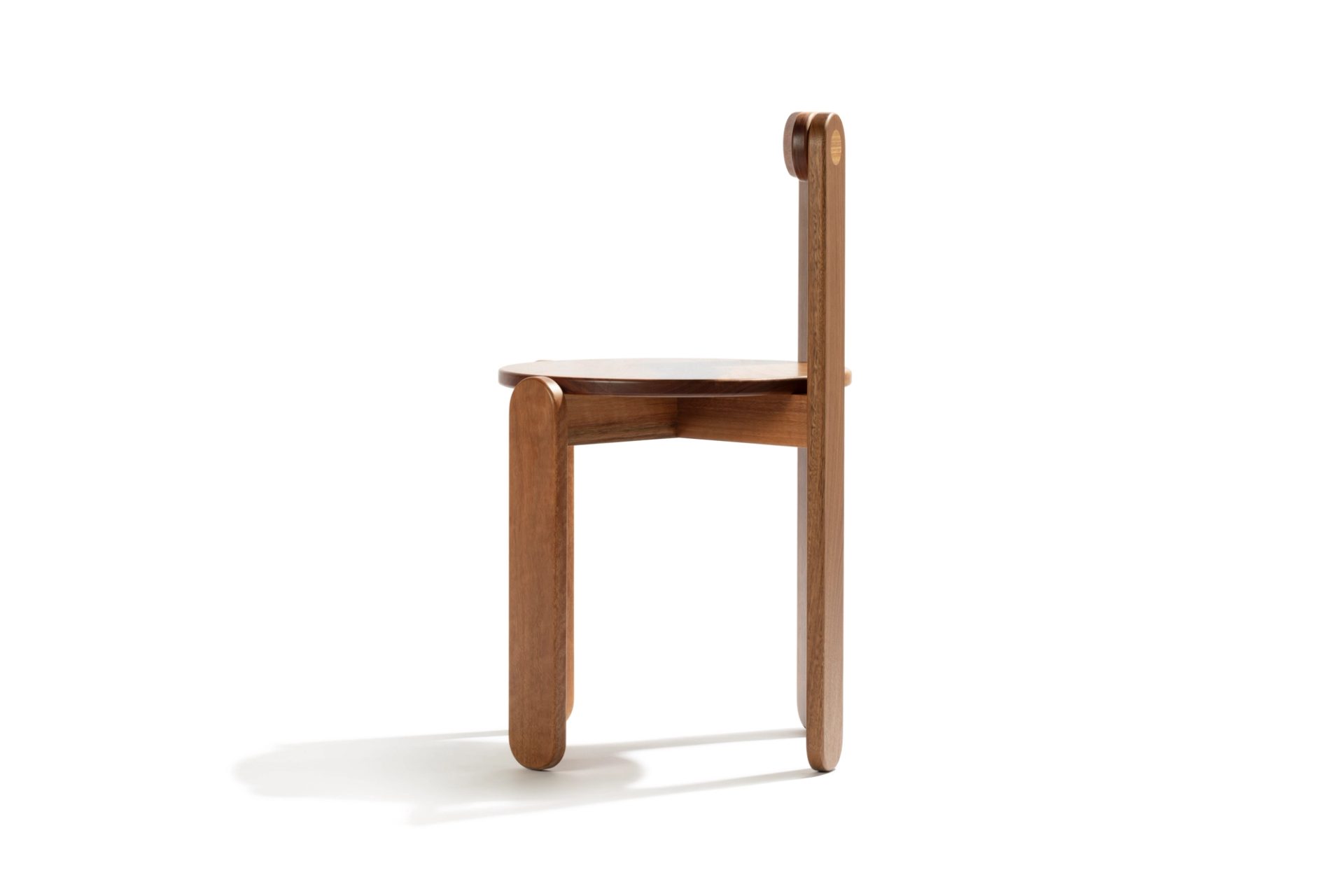
AY What were your initial thoughts when presented with the opportunity to design a chair for the new building at Powerhouse Castle Hill?
KR I was incredibly flattered and excited to have my work considered as part of a project that celebrates and highlights Australian timber. I’m very passionate about local Australian timbers, particularly the many varieties of eucalypts we have, so it was great to have the opportunity to bring my chairs to life in an Australian timber native to the Castle Hill area.
AY What drew you to creating flexible furniture and creating pieces for smaller spaces? Did this change when considering the collaboration space in Building J at Powerhouse Castle Hill?
KR My interest in creating pieces for small footprint living stemmed from my own experiences living in tiny inner-city apartments. I found myself needing furniture that could be flexible and compact, yet still retain individuality and personality. I often find that unique, well-designed furniture is made for grand homes that have the space for large statement pieces, however options can be limited when it comes to high quality, original design that’s more compact. With so many young people living in small apartments due to the housing affordability crisis, I feel this is an important demographic for designers to focus on and a topic I’m passionate about exploring in my own work.
AY A vital project element was incorporating spotted gum, which is endemic to the Castle Hill area. What was using this material like and did it present any challenges?
KR Although it’s a eucalypt like the shining gum the Penny chair is usually made from, spotted gum is quite a different timber in both appearance and makeup, so I’ve really enjoyed getting to know this timber more! Being such a dense timber with interlocked mixed grain, all the rounded edges and circular seat bases in the design had a higher chance of chipping out when shaping. I work with the very skilled Vivienne Wong, who produces many of my designs including the Penny Chair, so they turned out fantastic, but they did require much more time for careful shaping of the timber to get a clean finish. The rigid and heavy density of the timber also meant that thinner veneers had to be used for the bending of the curved seat back, and because of the natural oiliness of spotted gum, a different type of glue had to be used to make sure there was a really good bond between the layers. Shining gum timber has a very pale straw colour, so it was great seeing the chairs come to life in spotted gum with its deeper, rich chocolatey tones. I was blown away by how much it changed the whole feel and character of the chair!
AY Why do joy and a sense of homeliness play such a significant role in the visual language of your works?
KR The importance of joy and homeliness in the visual language of my work is influenced by my strong belief that our spaces have a profound impact on our mood and mindset. I’m quite a homebody, and like many others, I find comfort and contentment in the spaces surrounding me. I believe these cosy feelings are heavily influenced by the furniture and objects we choose to make our spaces feel special. There are so many uncontrollable forces that can negatively affect how we feel, so I like the idea of creating little pockets of happiness in the places we spend the most time. I also try to keep things light-hearted by creating playful pieces that feel approachable, while still offering the same quality benefits as more traditional high-end furniture.
AY What does it mean to you as an Australian designer to have work commissioned by Powerhouse?
KR As I'm still in the early stages of my career, it's incredibly rewarding to see one of my designs featured in the new Powerhouse building among other esteemed Australian designers and makers whom I admire. Being included within such an incredible cultural institution feels truly special!
AY Do you have any upcoming projects, plans and works you'd like to share?
KR Creating the Penny Chair in spotted gum has inspired me to release the design in a range of other timbers as well as an upholstered version. I’ve been specifically looking at recycled textiles and plant-based leather alternatives, such as cactus and apple skins, which I hope to have available in the coming months.

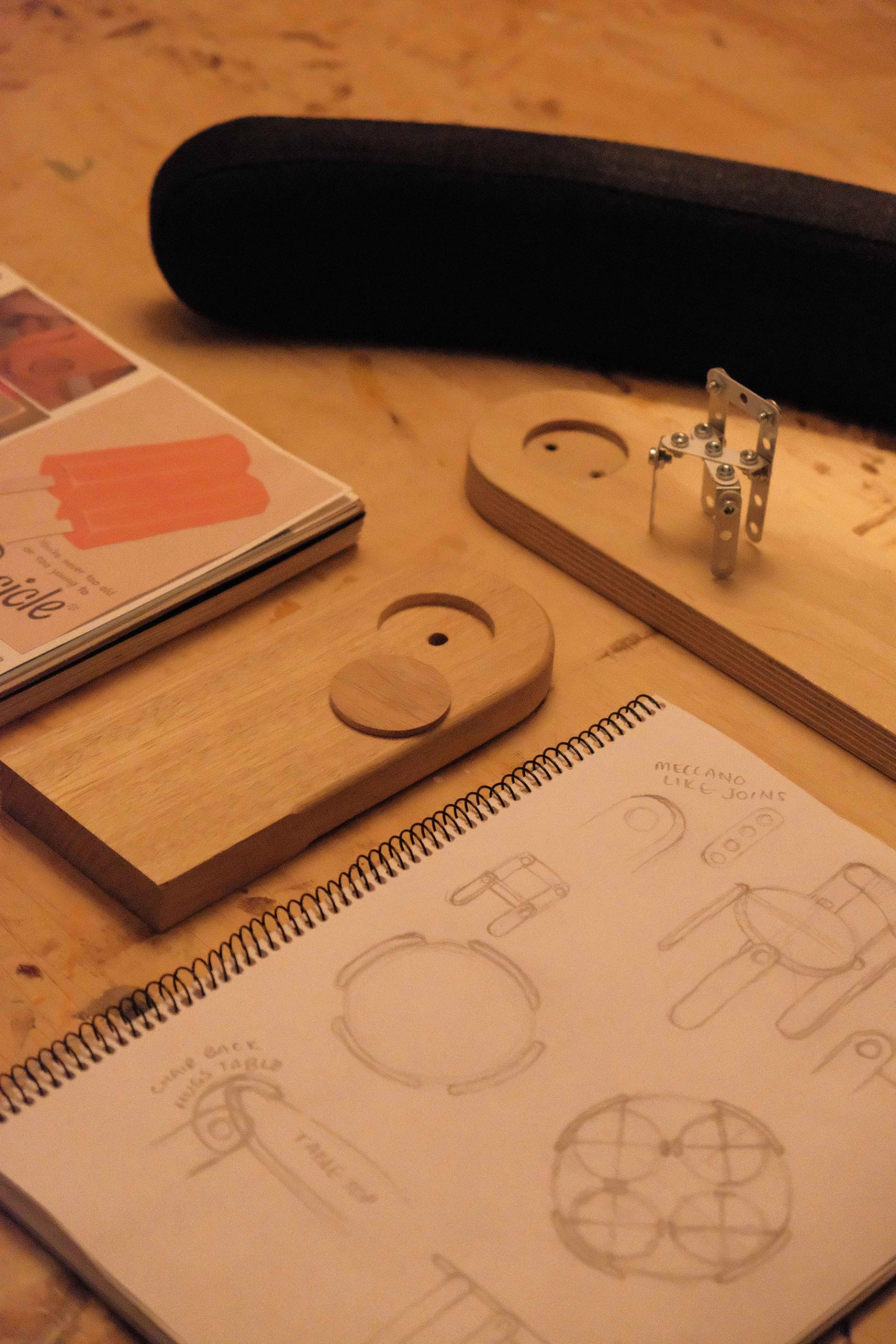
Dowel Jones
‘We believe it’s possible to still produce Australian-made products so long as you’re working within the constraints of what's feasible. We work with manufacturers like they are collaborators rather than suppliers.’
Dowel Jones is a furniture company dedicated to creating objects that are anything but ordinary. Founded in 2013 by designers Dale Hardiman and Adam Lynch in 2013, the brand has been widely acknowledged locally and internationally for its playful and experimental designs. Dowel Jones’ minimalist philosophy aims to perfectly balance functionality and a wondrous childlike spirit, which is evident in recent works such as an item titled ‘This is not a coffee table book, this is a piece of wood’ and the Flower Foldy Table. In recent years, the studio has collaborated with artists and designers such as Claire Mueller of ACID FLWRS and Ethiopian-Norwegian artist Olana Janfa.
In 2023, Emma Elizabeth collaborated with Powerhouse to commission Dowel Jones for a reinterpretation of the company’s Simon Says Chair using spotted gum.
Andrew Yee spoke with Hardiman and Lynch about incorporating play into the design process and the importance of working with local businesses.


Andrew Yee What were your initial thoughts when presented with the opportunity to design a chair for the new building at Powerhouse Castle Hill?
Dowel Jones To rethink a pre-existing piece in a site-specific timber was an amazing opportunity, along with joining other Australian designers within the collection.
AY There is an element of play in all your works. How do you introduce experimentation into the design and production process?
DJ I think because we founded the brand on play and experimentation it’s always been a part of what we do, even after nine years. As we know the Australian-made manufacturing processes, we understand what we can do throughout the design and production processes. We can rapidly iterate variations of products and understand how they’ll be made. We didn’t really work for other furniture brands prior to founding Dowel Jones, so the only process we know is the one we lead now.
AY A vital project element was incorporating the spotted gum, which is endemic to the Caste Hill area. What was it like to use this material and did it present any challenges?
DJ As we work on custom projects frequently, working with spotted gum felt natural. We’ve always produced our timber products in house, so the timber team has a huge wealth of knowledge.
AY Why is it essential for you to source production locally in Geelong?
DJ We founded Dowel Jones with the intention to produce contemporary Australian-made pieces and after nine years this is still our aim. We believe it’s possible to still produce Australian-made products so long as you’re working within the constraints of what's feasible. We work with manufacturers like they are collaborators rather than suppliers.
AY What does it mean to you as Australian designers to have work commissioned by Powerhouse?
DJ It’s meaningful to us that we produced a chair for this project alongside many other Australian designers we respect and admire. We’ve long worked with galleries and institutions in Melbourne, so it’s wonderful to be included in the collection at Powerhouse Museum!
AY Do you have any upcoming projects, plans and works you'd like to share?
DJ In July we’ll celebrate our 10-year anniversary with a five-month-long exhibition at the Geelong Wool Museum. For the exhibition we’ve produced 12 new projects exploring previous and new collaborations in a space we’ve designed that we’re calling Dowel Jones House. Instead of presenting 10 years of the commercial production work we do, we’ll present 12 new experimental works.



Daniel Emma
‘This concept embodies everything we design and make: it is about creating approachable, fun and simple pieces that are void of pomp! If our work can make others smile and elevate their daily experience, then we have done our job.’
DANIEL EMMA is a design studio that celebrates our everyday rituals. Founded by Daniel To and Emma Aiston in 2008 with the aim to create a sense of childlike play in often overlooked objects. As To and Aiston aptly put it, their designs aimed to be 'just nice'.
As self-proclaimed enthusiasts of 'stuff' and 'things', To and Aiston have little interest in reinventing products. Instead, their hearts lie in creating joy in our day-to-day experiences by marrying their love of industrial design with their vibrant sense of self-expression. Recent designs include a hanging clock with a spiral of colourful stripes, a neon light that throws shapes like a toddler’s squiggle and a lit-up heart signs pointing to defibrillator units.
In 2023 DANIEL EMMA received two much celebrated commissions, the first from the NGV in Melbourne titled 'Up Down And All Around', the second from Emma Elizabeth collaborating with Powerhouse Museum for a reinterpretation of the studio’s Sit Chair, using the spotted gum tree native to Powerhouse Castle Hill.
Andrew Yee spoke with DANIEL EMMA about designs that are ‘just nice’ and versatile.


Andrew Yee What were your initial thoughts when presented with the opportunity to design chair for the new building at Powerhouse Castle Hill?
DANIEL EMMA It was a nice surprise!
AY What does it mean for you to produce designs that are ‘just nice’?
DE This concept embodies everything we design and make: it is about creating approachable, fun and simple pieces that are void of pomp! If our work can make others smile and elevate their daily experience, then we have done our job.
AY A vital project element was incorporating the spotted gum, which is endemic to the Castle Hill area. How do you feel it changed the visual identity of the Sit Chair?
DE The Sit Chair is a versatile piece – it was purposely designed this way. The framework is utilitarian and basic, with a few unexpected details, enabling whatever is used for the seat to shine, whether it is upholstered, painted or solid timber.
AY The Sit Chair was originally created as part of JamFactory’s jam collection. What is the key to maintaining the creative identity of DANIEL EMMA when you enter collaborations for large-scale client work?
DE Working with other like-minded companies has always been a big part of our studio practice. For us it’s paramount the collaboration creates a product that is a unique combination of both brands’ values.
AY What does it mean to you as Australian designers to have work commissioned by Powerhouse?
DE To have our work included in such an iconic location is a huge honour!
AY Do you have any upcoming projects, plans and works you'd like to share?
DE After a busy 18 months of big external projects, this year we are concentrating more on our self-produced pieces and hope to release several new products later in the year.
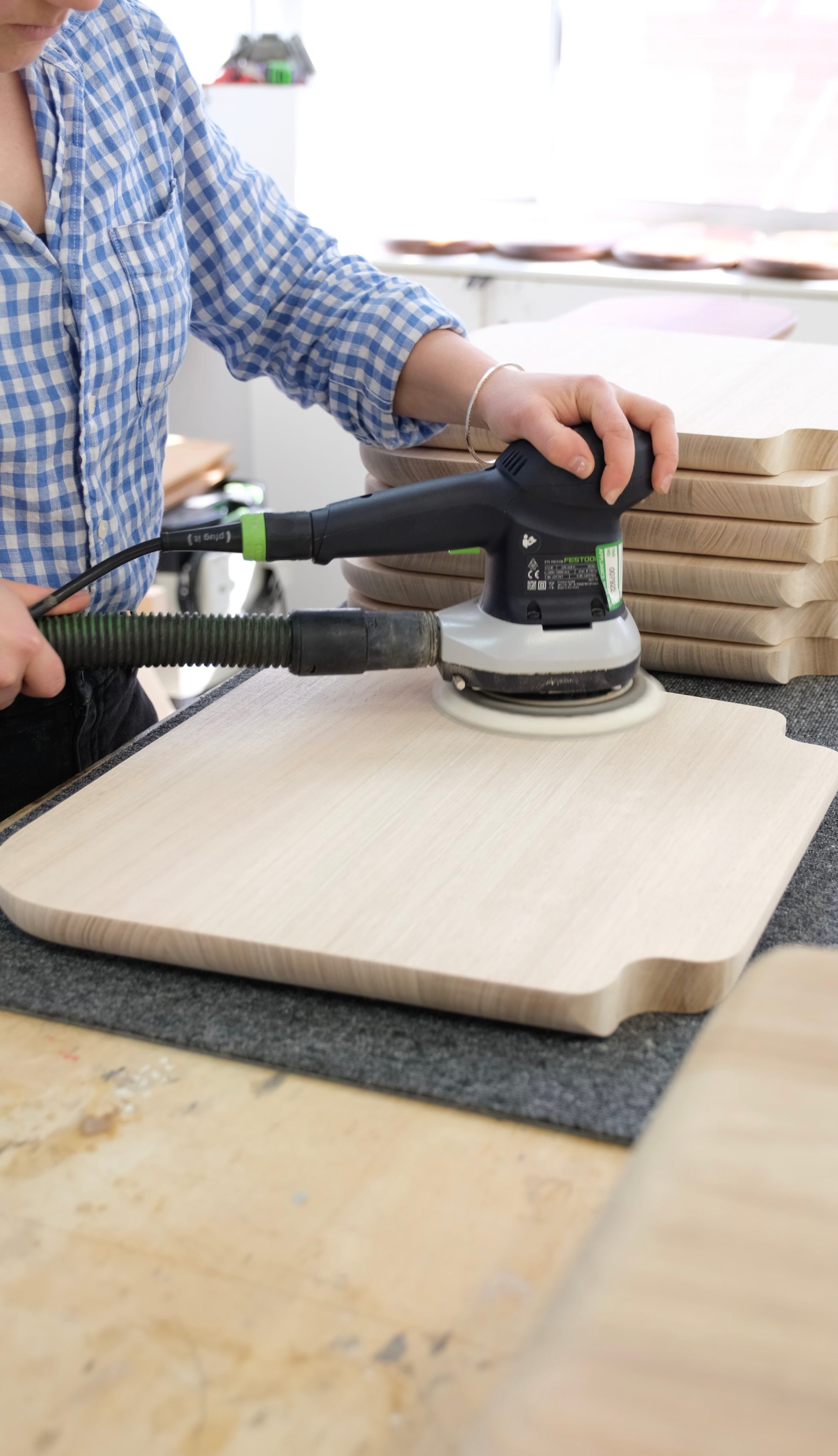

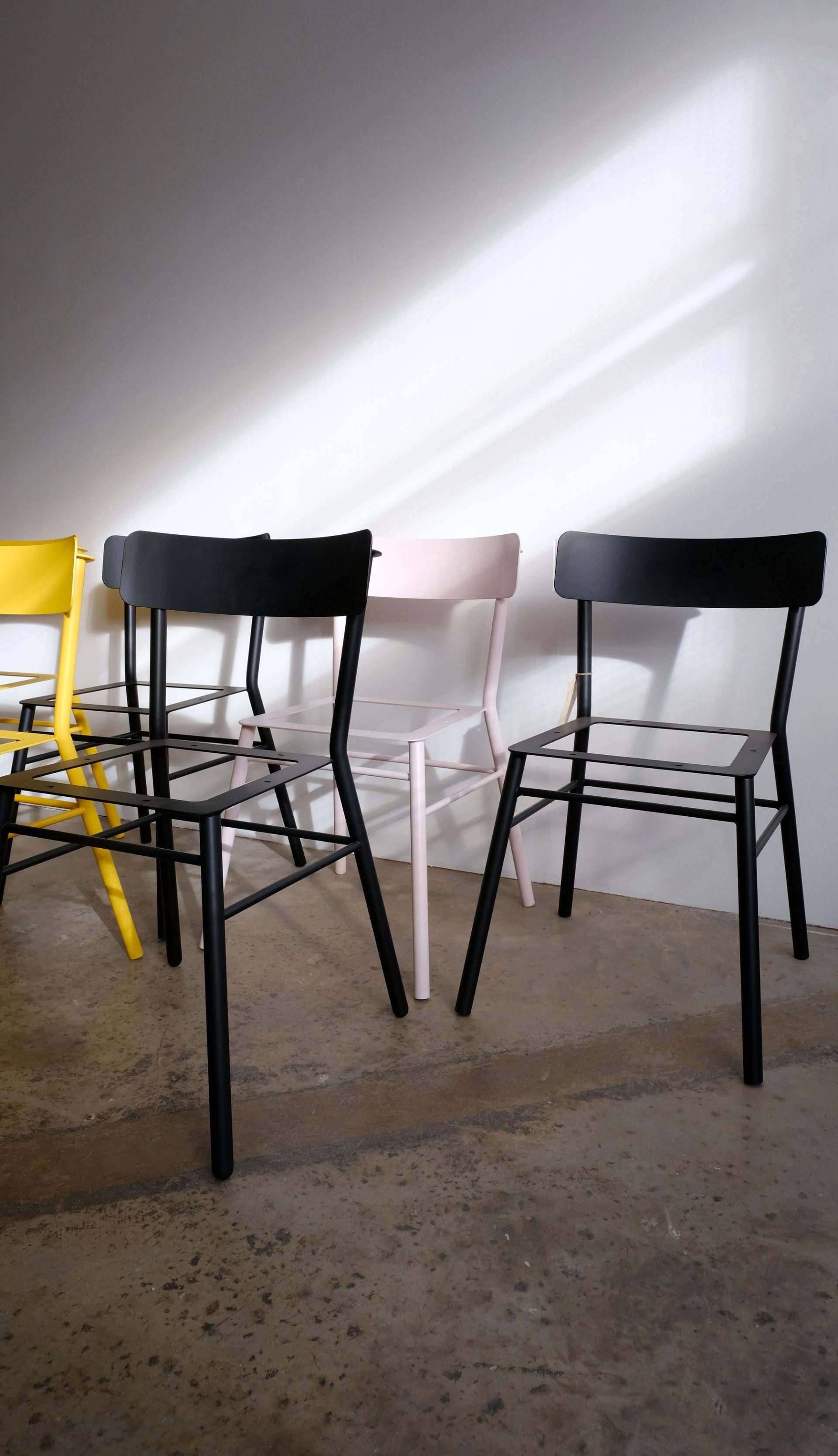
Alexander Lotersztain
‘We had a footprint to work with and we wanted to make the most out of the space. Creating spaces within spaces with functional artwork allows for multiple uses and experiences: work, play and rest. The randomly placed stainless steel custom BRUT-AL benches give a playful compliment to the building's architectural skin.’
Alexander Lotersztain is a designer and director of Derlot, a contemporary furniture brand based in Brisbane. He is renowned for his human-centric design approach, which prioritises functionality and form. So, despite an ultra-modern aesthetic, Lotersztain aims to avoid alienating users by encouraging interactivity over spectatorship. He is involved in various design pursuits, including architecture, furniture, interiors, objects, marketing and branding, and has been invited to participate in internationally recognised design panels.
In 2023, Emma Elizabeth worked with Powerhouse to commission Lotersztain to create outdoor seating known as BRUT-AL, comprising five horizontally placed stainless steel monoliths located in the north courtyard of Powerhouse Castle Hill.


Andrew Yee What were your initial thoughts when presented with the opportunity to design furniture for Powerhouse Castle Hill?
Alexander Lotersztain Who wouldn’t want to be part of such an amazing project, incredible architecture and curation!
AY How did the environment influence the choice of stainless steel as a material and the scale of the pieces?
AL We had a footprint to work with and we wanted to make the most out of the space. Creating spaces within spaces with functional artwork allows for multiple uses and experiences: work, play and rest. The randomly placed stainless steel custom BRUT-AL benches give a playful compliment to the building's architectural skin.
AY What does taking a human-centric approach to design mean to you? How did it influence the creation of BRUT-AL?
AL Human-centric design for me considers the entire user experience, including factors such as usability, aesthetics, accessibility and emotional impact. With BRUT-AL what I was trying to achieve was a striking installation playing in the realm of sculptural art and design that is not only functional but also enjoyable and meaningful for users.
AY Part of your practice is to consider the role design plays in an ever-evolving world. Why is this important to you?
AL Design possesses the remarkable ability to inspire, inviting individuals to cultivate fresh perspectives about their surroundings. When executed effectively, good design serves as a catalyst for positive change, as it engages participants in a collaborative experience.
AY What does it mean to you as an Australian designer to have work commissioned by Powerhouse ?
AL Being commissioned by Powerhouse holds significant meaning for me as an Australian designer. It's not only a recognition of my craft and creativity but also an opportunity to contribute to the cultural heritage of our nation. Design is a powerful medium through which stories are told, histories are preserved and ideas are shared. Having my work showcased at Powerhouse Castle Hill allows me to connect with a broader audience, shaping perceptions, sparking conversations and leaving a lasting impact on our collective understanding of design and its role in society. It's a privilege and responsibility I deeply value.
AY Do you have any upcoming projects, plans and works you'd like to share?
AL We are working on a number of projects, from interiors to new furniture collection for Derlot, and probably the most exciting is our work on a new sustainable bioplastic material specially formulated for roto moulding in collaboration with the University of Queensland. This will be a world-first fully biodegradable roto-mouldable material. After almost three and a half years in the making, we are now on the final stage of real size prototype testing. I can’t wait to share this with the world, hopefully very soon.


Adam Goodrum
‘As human beings, we naturally gravitate toward beautiful and functional environments. Design should, therefore, strive to create spaces and objects that enhance our lives in both aesthetic and practical ways. ’
Adam Goodrum is an industrial designer from Australia who specialises in creating furniture, lighting and other functional objects. Goodrum became passionate about maths and art from an early age, leading him to study Industrial Design at the University of Technology Sydney. He continues to combine these two passions in his designs, allowing geometry to give form and art to dictate expression.
Rising to prominence in 1997, when he was named Sydney Morning Herald Young Designer of the Year, Goodrum quickly gained accolades locally and internationally. In 2004 he won the Bombay Sapphire Design Discovery Award with his Eve chair and in 2008 he collaborated with Guilio Cappellini, owner of Italian furniture house Capellini, who put his now-iconic Stitch chair into production. His recent collaborations include Boab vases, the Carousel Table by Paris Gallery Gossere and a Volley outdoor furniture range made by Australian manufacturer Tait. His works appear in galleries and museums around the world, including the London Design Museum, Design Museum Gent (Belgium), National Gallery of Victoria, Art Gallery of Western Australia, National Gallery of Australia and Powerhouse.
Emma Elizabeth assigned Goodrum the task of reinterpreting his Don chair in a new spotted gum design for the collaboration space in Building J at Powerhouse Castle Hill.

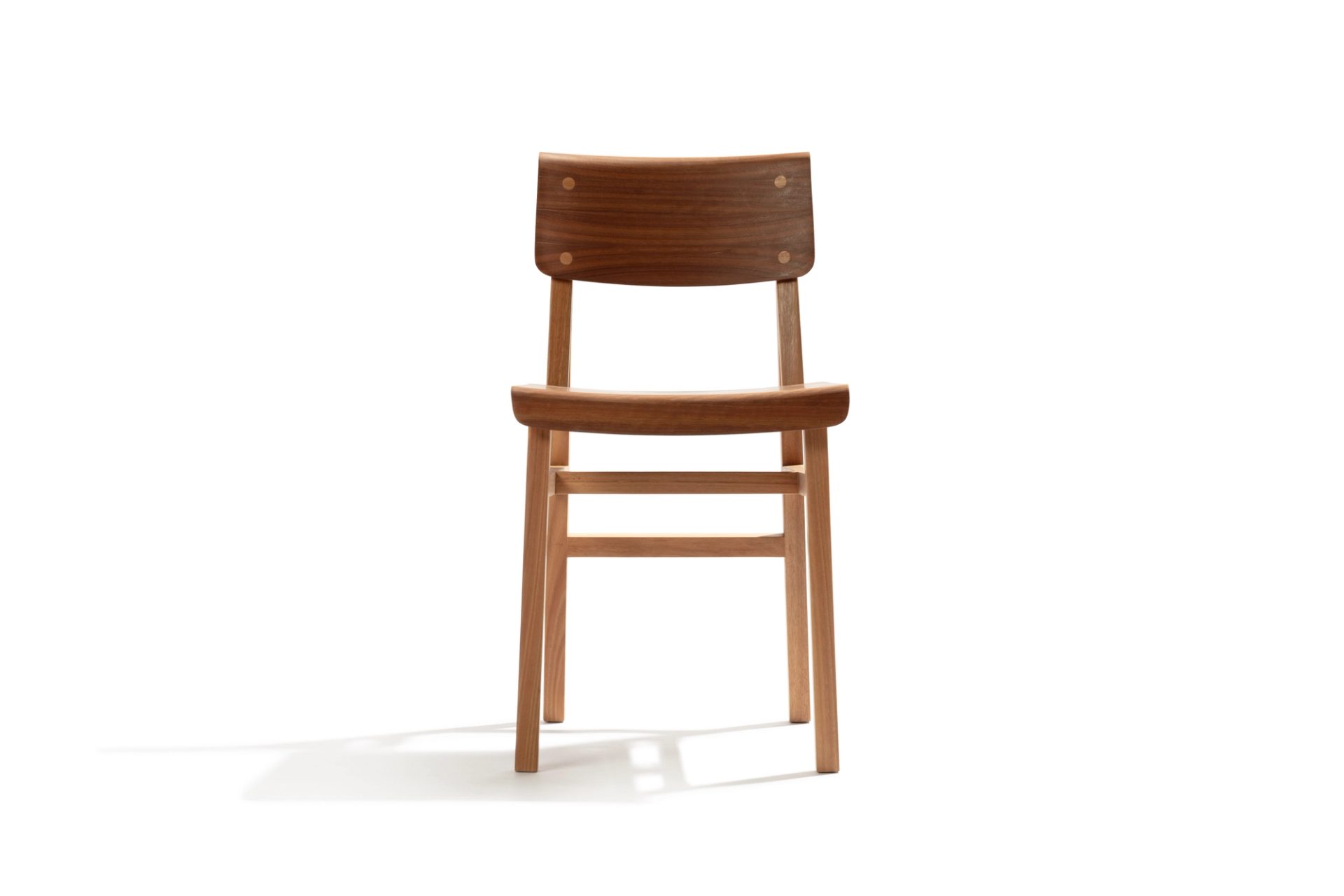
Andrew Yee What were your initial thoughts when presented with the opportunity to design new works for Powerhouse Castle Hill?
Adam Goodrum It’s always such a huge honour to be approached to have work in a significant institution. I have my Chameleon tables in the work areas, and Don chairs made from spotted gum in the collaborative areas. The chair was originally designed for American Hardwoods to promote Tulip and Cherry wood, it then went into production with NAU.
AY A vital project element was incorporating wood from the spotted gum tree, which is endemic to the Caste Hill area. What was using this material like and did it present any challenges?
AG Local woodworker Jack Standard of Iluka Studio made the chairs. He has good experience working with spotted gum and its challenges, as it has a lot of variation in the grain, which can result in spitting. It also has an oily make up which can make gluing difficult. One has to be careful with timber selections. With the Don chair I like to express joints with different colours. The spotted gum works well because of its diversity in colours.
AY What does it mean for a product to justify its existence?
AG As a designer it is fundamental that we practise in an ethical and sustainable manner. I firmly believe any design outcome must be rigorously examined and interrogated before it is physically realised. Whether I'm creating art-driven or functional objects, my primary criterion is that the design must provide something meaningful and unique.
Design is about creating environments and objects that are not only beautiful but also highly functional. Beauty and functionality should go hand in hand in design. Innovation, on the other hand, is the ability to challenge conventional design paradigms and introduce new, more efficient and intriguing ways of achieving form and function. As human beings we naturally gravitate toward beautiful and functional environments. Design should, therefore, strive to create spaces and objects that enhance our lives in aesthetic and practical ways.
AY In the past you've professed to work on several projects simultaneously. Why is this vital to your thought processes?
AG I enjoy the variation in briefs that comes with working with different brands or products because there is an inherent challenge in the creative agility needed. This requires curiosity in the creative process which I value. I find inspiration in a lifetime of experiences rather than specific objects or designers. For example, I love art and mathematics and feel this finds form in my designs that celebrate colour and geometry. I try to constantly look for inspiration outside the realm of furniture design – whether that be a clever mechanical connection, or in seeing something unique in the way two people converse. For me this is a continual process that may spark a thought or stimulate the growth of an idea.
AY What does it mean to you as an Australian designer to have work commissioned by Powerhouse?
AG When I moved from Perth to Sydney to study Industrial Design at UTS, I would constantly visit Powerhouse Ultimo for inspiration. I have heard many amazing people speak and attended numerous incredible exhibitions.
I feel very honoured to have been included in a number of exhibitions at Powerhouse such as Out of Hand, New Australian Design and recently 1001 Remarkable Objects. I also have a number of pieces in the museum's permanent collection. It is a huge honour to have a relationship with this incredible institution.
AY Do you have any upcoming projects, plans and works you'd like to share?
AG I am working on some Swiss-made luxury mechanical watches, a number of furniture collections that will be released throughout the year, and a piece for Adam and Arthur that will be presented at Tolarno Galleries for Melbourne Design week. It will be our most ambitious design to date.

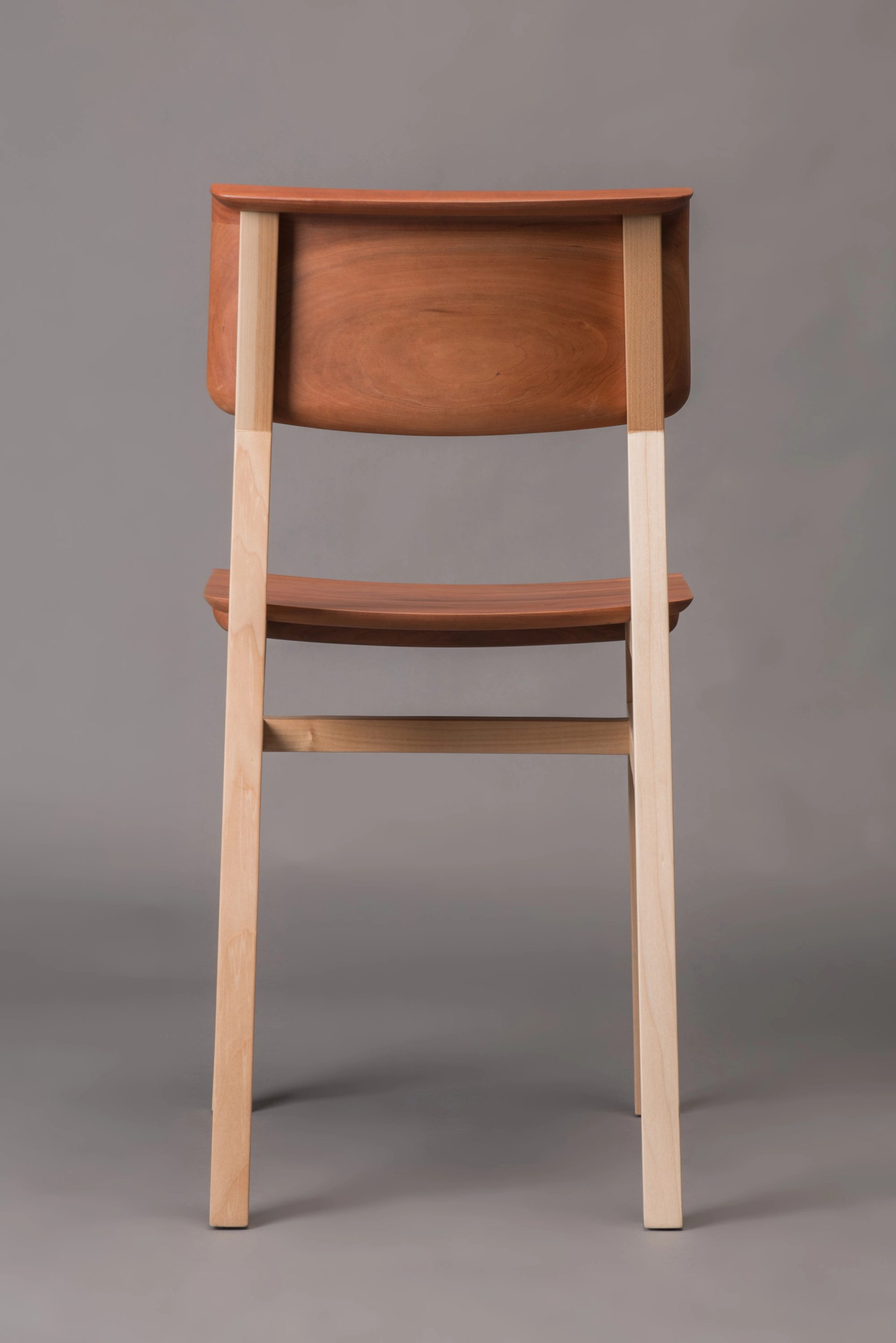
More
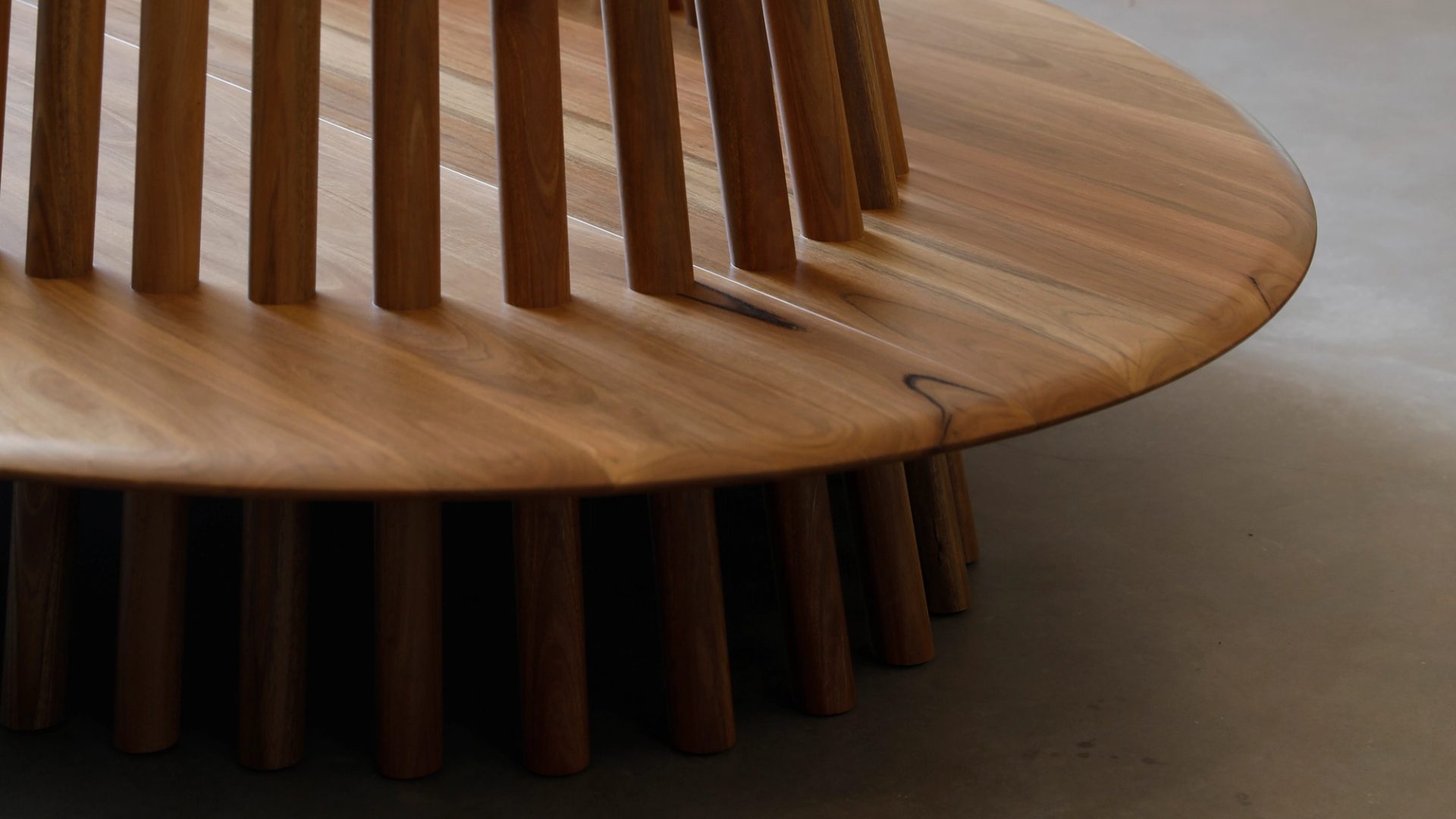
Tom Fereday
Tom Fereday created three furniture designs for Powerhouse Castle Hill including the ottoman at the entrance of Building J, developed in collaboration with Evostyle.

Powerhouse Castle Hill
Located on Dharug land. A storehouse for the Powerhouse Collection supporting research and conservation, presenting exhibitions and programs.Learn more
















